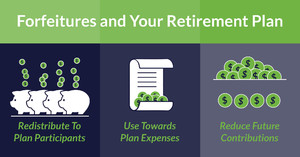Posted on Jan 14, 2020
Understanding How Forfeitures Work in Your Retirement Plan
When we talk about 401(k) retirement plans, we sometimes focus on the contributions made by employees that are always immediately vested. In other words, it's their money and they can always withdraw it without forfeiting any - subject to certain IRS rules about early withdrawals.
We know, of course, that you may also make profit sharing or matching contributions to your plan, too. These contributions may be, and commonly are, subject to a vesting schedule. Vesting over a period of years provides an incentive for your employees to stay with your company and provides you with some flexibility in how you choose to share the wealth.
When an employee leaves before being fully vested, the non-vested portion of their account is forfeited back to the plan. Generally, your plan has one of three options about how to use forfeited monies:
- You can redistribute the forfeited amount to the remaining eligible participants.
- You can apply the forfeited money towards reasonable plan expenses. This reduces your out-of-pocket expense of maintaining your plan.
- Or the forfeited money can be used to reduce future contributions.
Your retirement plan document spells out exactly how forfeitures are to be treated. In other words, the definition of vesting and forfeitures and how they'll be handled should be clear to you and your employees.
What is important is that as a plan design feature, vesting and forfeiture rules associated with employer contributions can be a useful tool to help you offer a potentially lucrative employee benefit while maintaining control of how these dollars are ultimately distributed.
If you have any questions about how vesting and forfeitures work in your plan, don't hesitate to reach out to chat. We're here to support you.

